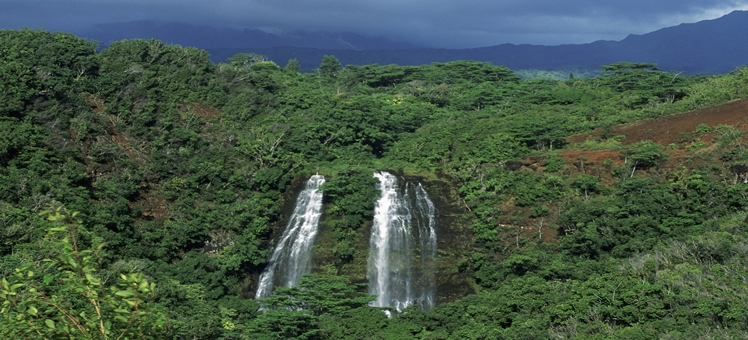
The multitude of natural attractions present on ‘Big Island’s’ shores is truly astonishing and as the archipelago’s largest, and arguably most diverse islands, you won’t be short of things to do. From active volcanoes Kilauea and Mauna Loa, to historical parks and gardens and black sand beaches to majestic waterfalls you’ll find plenty to keep yourself occupied. Whether you’re on a romantic honeymoon getaway, on a family holiday, or just looking to travel off the beaten path, ‘Big Island’ is sure to cast a spell over all those who travel here.
Hawai’i Volcanoes National ParkFirst established in 1916, this area of southern ‘Big Island’, spanning the districts of Puna and Ka’u, is one of the island’s biggest draws. Designated as a UNESCO World Heritage Site in 1987, climates here range from lush tropical rainforests to the arid and barren Ka’u desert – not to mention the two vast volcanic peaks of Mauna Loa and Kilauea. Encompassing over 500 square miles of land, there is plenty of space in which to go hiking and discover the local flora and fauna. A section known as the ‘Hawaii Volcanoes Wilderness’, in the southwestern corner of the park, offers some of the best hiking trails anywhere on the island.
The Great Crack
Formed as a result of Hawaii’s frequent volcanic and seismic activity, the ‘Great Crack’ is a major attraction for tourists too visit. At eight miles long, eighteen meters across, and eighteen meters deep it’s certainly impressive. You can find excellent hiking trails here which lead to rock walls and archaeological sites which date as far back as the 12th century. Approximately 1,951 acres (7.90 km2) of private land were purchased during the presidency of Bill Clinton in order to safeguard this heritage as well as the local wildlife species, which include endemic seabirds like the black-footed albatross.
James Kealoha Beach
Located in the Hilo district of the island, this four mile stretch of beach offers one of the best locations to enjoy the archipelago’s infamous crystal clear waters and palm fringed sand. This is a popular site for snorkelling, and turtles, reef fish and many other marine invertebrates can be seen. Other popular activities here include surfing, swimming at the more sheltered eastern end, pole fishing and spearfishing.
Akaka Falls State Park
Located about 11 miles north of Hilo, just off the Hawaii Belt Road, this park is a must for anyone who enjoys visits the island. The waterfalls in question are an impressive 422 feet tall, and they can be viewed from a great hiking trail – perfect for that photo opportunity.
Ka Lea
Known for being the southernmost point of the United States, this national historic landmark district is the perfect place to get that photo opportunity!
Amy B.H. Greenwell Ethnobotanical Garden
This 15 acre botanical garden, located in the island’s Kona district, is a botanist’s dream. Today the garden contains over 200 species of endemic, indigenous, and Polynesian-introduced plants that grew in Kona before the infamous British Explorer, Captain James Cook, arrived. On certain days it is possible to take a guided tour during which the use and significance of the more important plants are explained. Across the highway lies the Kona Coffee Living History museum – well worth a visit if you have time to spare.
Pacific Tsunami Museum
Given the amount of volcanic and seismic activity on the island, there have sadly been many tsunamis and other natural disasters here over the years. This museum, located in Hilo, is dedicated to the history of the 1946 Pacific tsunami and the 1960 Chilean tsunami respectively – both of which caused widespread devastation across ‘Big Island’. The museum is also dedicated to the education of people about tsunamis including why they occur, where they occur, and the systems which are in place in order to help warn people when they are forming.
Panaʻewa Rainforest Zoo
Located in Hilo, is located this small 12-acre zoo is the only one in the United States located within an actual rainforest. The Zoo has more than 60 species of animals on display, and the grounds feature more than 40 different species of plants, flowers, and trees. The most popular attraction of the Zoo is a male white Bengal Tiger known as Namaste.
Hakalau Forest National Wildlife Refuge
Just one of the many protected areas on ’Big Island’, this refuge is one of two units, along with the Kona Forest National Wildlife Refuge, that is managed as part of the ‘Big Island National Wildlife Refuge Complex’. It contains some of the last remnants of native montane forest in Hawaii. There are numerous endangered species here – one plant is only known to have five plants left! In order to safeguard this wilderness, access is restricted. However, the Upper Maulua Unit of the refuge is open to the public for wildlife-dependent activities such as hiking, bird watching and photography on Saturdays, Sundays and holidays.